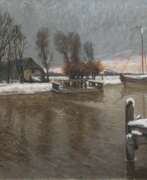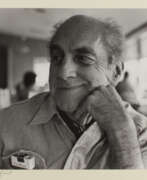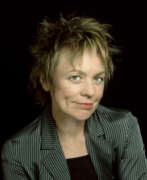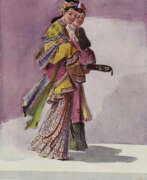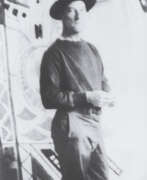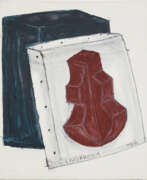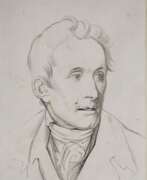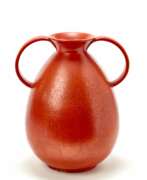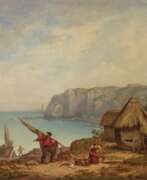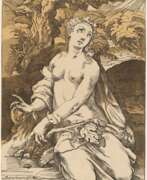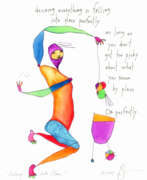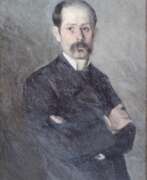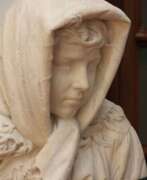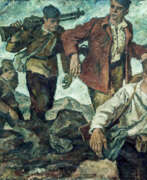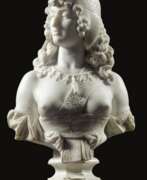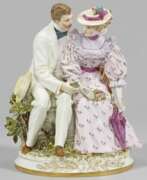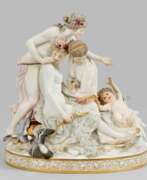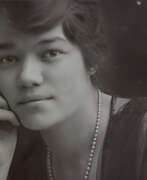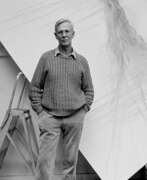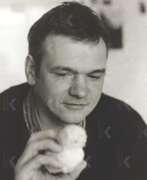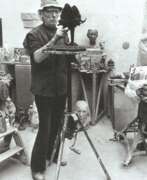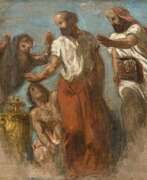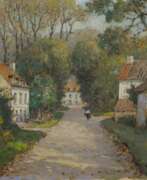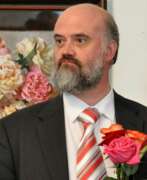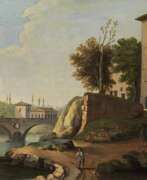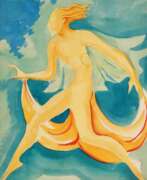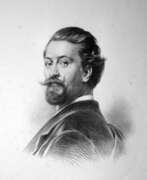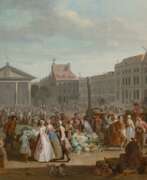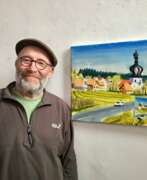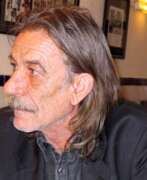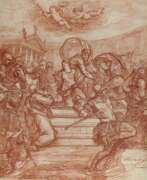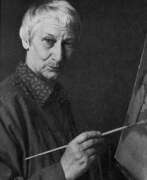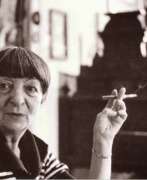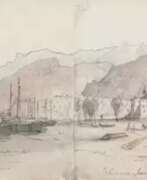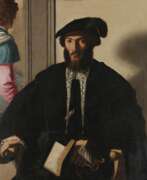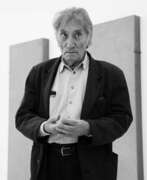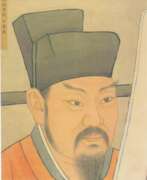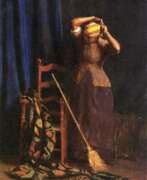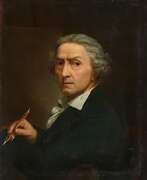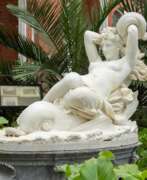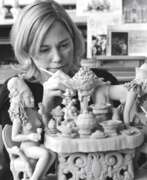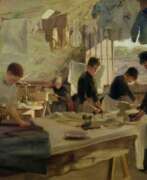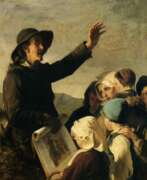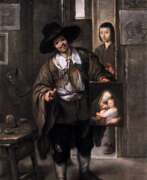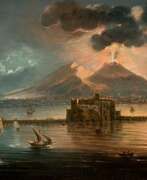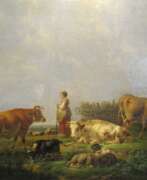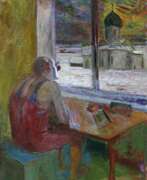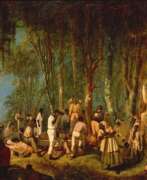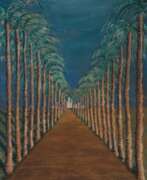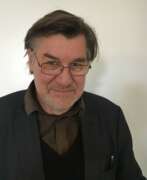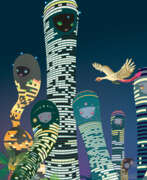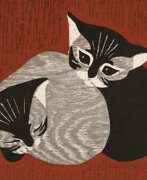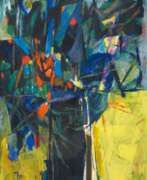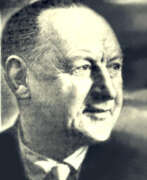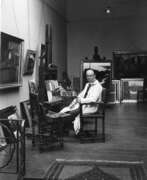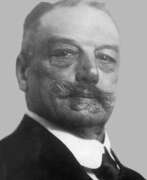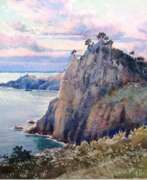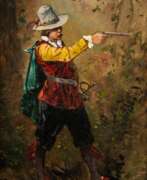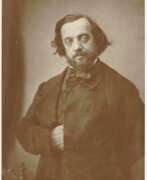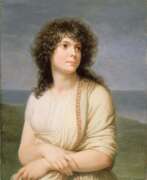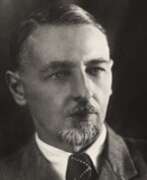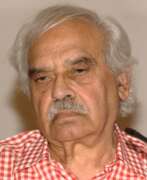Famous people


Sophie Gengembre Anderson was a British artist of French descent.
Fleeing the revolution in France, her family moved to the United States in 1848, and Sophie had a successful career in America for several years. She specialized in genre and portrait paintings depicting children and women, usually in rural settings.
In 1854 the Andersons moved to London and Sophie's work was well received and exhibited widely at the Royal Academy, the Royal Society of British Artists (RBA) and the British Institution.
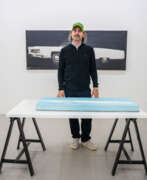

Joe Andoe is an American artist, painter, and author. His works have been featured in exhibits internationally and also numerous museums including the Denver Art Museum, the Detroit Institute of Art, the Museum of Fine Arts in Boston, and the Whitney Museum of American Art.
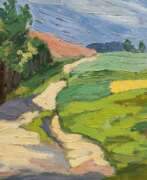

Louise Elisabeth Andrae was a German Post-Impressionist landscape painter and watercolorist. She studied with two landscape painters; Gustav Adolf Thamm in Dresden and Hans von Volkmann in Karlsruhe. She settled in Dresden, but spent long periods on the island of Hiddensee. There, she helped organize a group known as the Hiddensoer Künstlerinnenbund, an association of women artists that included Clara Arnheim, Elisabeth Büchsel, Käthe Loewenthal and Katharina Bamberg. They were regular exhibitors at an art venue known as the Blaue Scheune (Blue Barn), established in 1920 by Henni Lehmann. She also exhibited frequently with a group known as the Kunstkaten in Ahrenshoop.Wikipedia
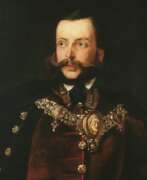

Manó Andrássy, full name Count Manó Andrássy de Csíkszentkirály et Krasznahorka was a Hungarian self-taught artist, caricaturist, and politician.
Count Mano Andrássy was an art collector, a member of the Hungarian Academy of Sciences, and a member of the Hungarian Parliament. He was at the origin of the Hungarian iron industry, developed iron ore mining and metallurgy, for his significant role in these endeavors he is still remembered by the name Iron Count.
Mano Andrássy left behind a diverse body of work. His caricatures of the vices of political and social life were known throughout the country. And drawings made during his travels to China and India were published in an album, he was elected a full member of the Hungarian Academy of Sciences.
He studied painting self-taught, and his most famous painting is a self-portrait. Andrássy was an avid art collector. He is also known as a philanthropist, and his collection of antiquities is part of the National Museum's collection.

Carl Andre is an American minimalist artist known for his sculptural works made of industrial materials such as metal plates, bricks, and concrete blocks. He was a key figure in the Minimalist art movement of the 1960s and 1970s, which emphasized the use of simplified forms and materials.
In the 1960s, Andre began creating his signature floor sculptures, which consisted of standardized units of metal, wood, or other materials arranged in simple geometric patterns directly on the ground. His work was often controversial, as many critics saw it as overly simplistic or even nihilistic. However, Andre's sculptures were also celebrated for their understated beauty and their ability to challenge traditional notions of art and sculpture.
Throughout his career, Andre has exhibited his work in major museums and galleries around the world. Andre continues to live and work in New York City, where he remains an influential figure in the art world.


Constantine Andreou (Greek Κωνσταντίνος Ανδρέου; Portuguese: Constantine Andreou) is a Greek artist and sculptor of Brazilian origin who had a very successful career for six decades. Many have praised Andreou as an outstanding figure in international art in the 20th century.
Constantin Andreou fought in the Greek army during World War II and joined the armed resistance after the occupation of Greece. After the war ended, Andreou received a scholarship from the French government in 1945 and moved to Paris. There, in 1947, he developed an innovative artistic technique in which he welded brass plates together for the first time. This technique allowed him to find new forms of expression in sculpture and made him an innovator of his time.
During his time in Paris, the artist worked for a time with Le Corbusier. Andreou's works were exhibited alongside those of famous artists such as Pablo Picasso, Henri Matisse and Max Ernst, which testifies to his outstanding artistic achievements.


Henry Andrews was a British painter of genre and historical scenes.
He is best known for his imitations and adaptations of Watteau, painting mainly romantic garden scenes as well as portraits. Andrews exhibited at the Royal Academy, as well as at the British Institution and the Society of British Artists.
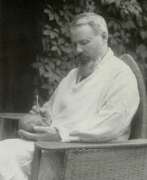

Nikolay Andreyevich Andreyev (Russian: Николай Андреевич Андреев) was a distinguished Russian sculptor, graphic artist, and stage designer, whose works have significantly contributed to the artistic landscape of early 20th-century Russia. Born into the rich cultural milieu of Moscow in 1873, Andreyev emerged as a pivotal figure associated with the Peredvizhniki group, a movement that sought realism and social critique through art. His early education under Sergey Volnukhin paved the way for a career that spanned various forms of artistic expression, including sculpture and graphic design.
Andreyev's works are known for their dynamic representation of figures and profound social commentary. Perhaps his most famous creation is the bronze statue of the celebrated writer Nikolai Gogol, unveiled in 1909. This statue, surrounded by bronze friezes depicting Gogol's characters, initially stood on Gogol Boulevard in Moscow. Its impressionistic style, however, attracted criticism, leading to its relocation in 1952. Another notable work, the "Woman reaper with a child," showcases Andreyev's adeptness at capturing the essence of Russian cultural symbols through sculpture. Cast in bronze, this work reflects Andreyev's ability to convey complex themes such as motherhood and labor with sensitivity and depth.
In his later years, Andreyev's artistic direction veered towards Socialist Realism, producing a prolific array of Leniniana - sculptures and graphic works of Vladimir Lenin. His commitment to this genre was profound, with around 100 sculptures and 200 graphic works dedicated to Lenin, marking a significant contribution to Soviet artistic propaganda. Additionally, his portrait of Lev Tolstoy stands as a testament to his versatility and depth as an artist, capturing the essence of the literary giant with striking realism.
Andreyev's legacy extends beyond his artistic achievements, with his works residing in prestigious collections such as the Tretyakov Gallery. His death in 1932 marked the end of a vibrant chapter in Russian art history, but his contributions continue to be celebrated for their artistic merit and historical significance.
For collectors and experts in art and antiques, the works of Nikolay Andreyevich Andreyev offer a unique glimpse into the cultural and political nuances of Russia during a transformative era. His sculptures not only stand as remarkable feats of artistic expression but also as enduring symbols of Russia's rich cultural heritage.
If you're intrigued by Andreyev's profound contributions to art and wish to explore his works further, consider signing up for updates. This subscription will keep you informed about new product sales and auction events related to Nikolay Andreyevich Andreyev, offering exclusive insights into the world of art and antiques.
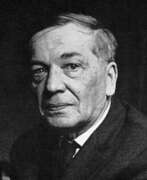

Mikhail Fedorovich Andrienko-Nechytailo (Russian: Михаил Фёдорович Андриенко-Нечитайло) was a Russian artist known for his contributions to the avant-garde movement. Born in 1894, he became renowned for his innovative approach to painting, stage design, and illustration. Andrienko-Nechytailo’s work is celebrated for its unique blend of Constructivism and Cubism, which set him apart from his contemporaries.
One of his special features was his ability to combine geometric forms with a vibrant color palette, creating visually striking compositions that challenged traditional artistic conventions. His works often explored themes of abstraction and the intersection of art and technology. His notable pieces are housed in prestigious collections, including the Tretyakov Gallery in Moscow and the Russian Museum in Saint Petersburg.
Collectors and art experts admire Andrienko-Nechytailo for his visionary approach and lasting impact on modern art. His legacy continues to influence contemporary artists and is a testament to his skill and creativity.
Sign up for updates on new product sales and auction events related to Mikhail Fedorovich Andrienko-Nechytailo. Stay informed about opportunities to add his remarkable works to your collection.
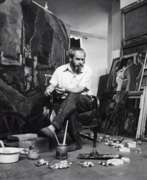

Nikolai Ivanovich Andronov (Russian: Николай Иванович Андронов) was a Soviet artist of the second half of the twentieth century. He is known as a painter, muralist and teacher, considered one of the founders of the "severe style" in the art of the USSR.
Nikolai Andronov actively worked to liberalize the Soviet art scene. At the beginning of his career, he created thematic paintings, later focusing on landscapes. The artist was also involved in the decoration of buildings, including the clubhouse of the Soviet Embassy in the United States, the Paveletsky Railway Station and subway stations in Moscow. From 1992, he taught at the Surikov Moscow Art Institute and headed the composition department.


Valery Vladimirovich Androsov (Russian: Валерий Владимирович Андросов) is a Soviet and contemporary Russian artist. He is known as a sculptor, architect, designer, painter, graphic artist and teacher.
Valery Androsov creates landscapes, still lifes and portraits, as well as fantasy works. He is also known as the author of a large collection of ex-libris that accurately convey the character and interests of book owners. At different periods he served as chief artist of the Mosstroiplastmass Combine and director of the Mytishchi Picture Gallery. He also created monuments to those who died in the Great Patriotic War and to the pilots of the Mytishchi Aero Club, showing his skill in various artistic directions.
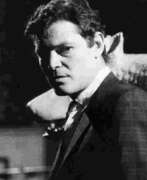



Fra Angelico, a name synonymous with the serenity and purity of Early Renaissance art, was a Dominican friar and Italian painter celebrated for his devout and luminous religious works. Born Guido di Pietro around 1395 in Vicchio, near Florence, he later became known as Fra Giovanni upon joining the Dominican order at Fiesole. His monastic life profoundly influenced his art, reflecting a deep spiritual commitment and a heavenly tranquility. Pope John Paul II recognized his sanctity by beatifying him in 1982, officially bestowing upon him the title "Blessed" and affirming his legacy as a bridge between heaven and earth through his art.
Fra Angelico's technical prowess and innovative approaches to composition and color set new standards in the art world. He was initially trained as an illuminator, which is evident in the delicate details and luminous quality of his works. His art was not confined by his religious duties; instead, his position allowed him to advance the Dominican order's mission through visually compelling narratives that spoke directly to the viewer's soul. His works, including altarpieces and frescoes, are revered for their serene religious attitude and classical influence, embodying the Early Renaissance spirit that sought to harmonize Christian themes with the natural world and human emotion.
Among his most notable contributions are the frescoes at the convent of San Marco in Florence, commissioned by Cosimo de' Medici. These works display Angelico's mastery over perspective and his ability to create a spiritual atmosphere that invites contemplation. The Annunciation, one of his most famous frescoes at San Marco, exemplifies his use of architectural space to frame the sacred narrative, integrating the divine with the everyday. His altarpieces, characterized by their detailed figures and harmonious compositions, were innovative in their unified presentation of sacred stories, moving away from the segmented Gothic style towards a more cohesive and immersive narrative experience.
Fra Angelico's influence extended beyond his lifetime, shaping the trajectory of Renaissance art through his integration of humanistic principles with devout Christian faith. His works are preserved in some of the world's most prestigious museums, including the Museo Diocesano in Cortona, the Uffizi Gallery, and the Museo del Convento di San Marco in Florence, continuing to inspire awe and reverence among viewers.
For collectors and experts in art and antiques, the legacy of Fra Angelico offers a window into the soul of the Renaissance, where beauty and spirituality converge. To stay informed about new product sales and auction events related to this pivotal artist, signing up for updates is a prudent step towards enriching one's collection with works that embody the zenith of religious and artistic expression in the Early Renaissance.


Pieter Angellis, also known as Pieter van Angellis, Peter van Angellis or Peter Angelles, was a French-born painter. He worked in Flanders, Germany, Italy, England, and France and is known for his landscapes and genre paintings of urban life. Angelles was a member of the Guild of St. Luke in Antwerp and Düsseldorf.
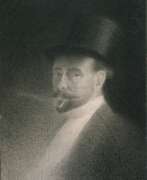

Charles Angrand was a French painter and draftsman known for his Pointillist style and depictions of rural life. Born in Normandy, Angrand moved to Paris in his youth to study art. He was initially influenced by the Realist and Impressionist movements, but later developed his own style of Pointillism, which he applied to landscapes, cityscapes, and genre scenes.
Angrand's Pointillist technique involved the use of small, distinct dots of color that, when viewed from a distance, blended together to create the impression of a more vibrant and luminous image. His work often focused on the people and landscapes of rural France, and he was particularly interested in the effects of light and atmosphere on his subjects.
Angrand exhibited his work at many important exhibitions, including the Salon des Indépendants and the Salon d'Automne in Paris. He was also involved in the Neo-Impressionist movement, which sought to explore the scientific principles of color and optics in painting.
Despite his contributions to the development of Pointillism, Angrand's work was largely forgotten after his death, and it was not until the mid-20th century that he began to be rediscovered by art historians and collectors. Today, his paintings are represented in many important collections, including the Musée d'Orsay in Paris and the Art Institute of Chicago.
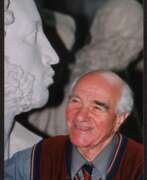

Mikhail Konstantinovich Anikushin (Russian: Михаил Константинович Аникушин) was a Soviet and Russian sculptor, celebrated for his monumental works that have left a lasting legacy in the art world. Born on September 19, 1917, in Moscow, Anikushin's sculptures are a testament to his profound skill and dedication to depicting historical and cultural figures with a dynamic expressiveness that brought them to life. His most notable works include monuments dedicated to Alexander Pushkin, found at the Pushkinskaya Station of the Saint Petersburg Metro and Arts Square in Saint Petersburg, as well as a monument to Vladimir Lenin at Moskovskaya Square in Saint Petersburg.
Anikushin's career was distinguished not only by his artistic achievements but also by the honors he received, reflecting the impact of his work on Russian culture. He was awarded the title of "Honored Artist of the RSFSR" in 1957, "People's Artist of the USSR" in 1963, and became a full member (academician) of the Russian Academy of Arts in 1962. His dedication to capturing the spirit and essence of his subjects, particularly Alexander Pushkin and Vladimir Lenin, showcases his innovative approach to sculpture, moving beyond traditional standards to depict his subjects in active, dynamic poses.
The Presidential Library collection dedicated to Anikushin commemorates the 100th anniversary of his birth, highlighting his significant contributions to Russian sculpture in the 20th century. Anikushin's works are integral to the aesthetic and cultural landscape of Leningrad (now Saint Petersburg), contributing to the city's historical and artistic identity. The collection also emphasizes his role in the community, including his public service and the enduring influence of his artistic vision on generations to come.
Collectors and experts in art and antiques recognize Mikhail Konstantinovich Anikushin not only for his technical prowess but also for his ability to imbue his sculptures with a sense of movement and emotional depth that resonates with viewers. His works remain landmarks, celebrated both in Russia and internationally, for their contribution to the cultural heritage.
For those interested in exploring the works and legacy of Mikhail Konstantinovich Anikushin further, signing up for updates can provide invaluable insights into new discoveries, exhibitions, and auction events related to this influential sculptor. This subscription is an opportunity to stay informed about the sales and exhibitions that continue to celebrate Anikushin's remarkable contribution to the world of sculpture.


Boris Izraelievich Anisfeld (Russian: Борис Израилевич Анисфельд) was a Russian-American painter, set designer, illustrator, and educator, celebrated for his vivid use of color and imaginative scenery. Born in Bessarabia, Russian Empire, in 1878, Anisfeld's artistic journey led him from the Odessa School of Art to the Imperial Academy of Arts in Saint Petersburg, where he absorbed the influences of prominent artists like Ilya Repin and Igor Grabar. His distinct style caught the attention of Sergei Diaghilev, leading to his work with the Ballet Russe before World War I.
Anisfeld's contributions to art extend beyond his canvas, as his theater designs for Diaghilev's Ballets Russes and collaborations with notable figures like Michel Fokine and Anna Pavlova showcased his ability to blend fantasy with performance. His work with the Ballets Russes, including designing the production of "Sadko" and executing the visions of other celebrated artists for stage sets, marked a significant period in his career before he immigrated to the United States in 1917.
In America, Anisfeld continued his legacy, taking on roles such as a teacher at the Art Institute of Chicago and contributing to the cultural landscape through his stage designs and paintings. His work is recognized for its innovative approach to color and form, bridging the realms of painting and theater design to create immersive, emotionally resonant artworks. Anisfeld passed away in 1973, leaving behind a body of work that continues to inspire and captivate audiences.
For collectors and experts in art and antiques, Anisfeld's work represents a fusion of Russian and American art traditions, enriched by his imaginative approach and vibrant palette. His contributions to the development of modern art and theater design underscore the enduring relevance of his creative vision.
To stay updated on exhibitions, sales, and auctions related to Boris Israelievich Anisfeld, sign up for updates. This subscription will ensure you're informed about new opportunities to explore and acquire works by this influential artist.
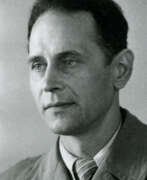

Vladislav Leopoldovich Anisovich (Russian: Владислав Леопольдович Анисович) was a Soviet artist of the mid-twentieth century. He is known as a painter, graphic artist and teacher, a representative of the Leningrad school of painting.
Vladislav Anisovich participated in various exhibitions since 1935. His work included portraits, historical and genre compositions, as well as landscapes. Among the famous paintings of the artist are "The passage of K. Voroshilov's detachment from Lugansk to Tsaritsyn", "Assault on Perekop" and others. The master taught at the Leningrad Institute of Painting, Sculpture and Architecture.
His works are in various museums and private collections in many countries, including the State Russian Museum.
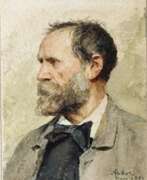

Albert Samuel Anker was a Swiss painter, gesture painter and graphic artist.
Albert studied at the École Nationale Supérieure des Beaux-Arts in Paris and exhibited his work at the Paris Salons, where he was awarded a gold medal in 1866. Anker painted many realistic portraits and genre scenes of ordinary Swiss life. In many of them he depicted children, including his own. Thanks to his paintings, Albert Anker was the most popular genre painter of 19th century Switzerland. He also decorated more than 500 earthenware plates for the Alsatian ceramicist Theodor Deck.
Anker was a member of the Grand Council of the Canton of Bern, initiated the creation of the city museum, and held the rank of officer of the Legion of Honor.
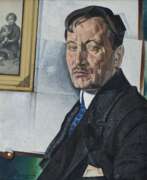

Yury Pavlovich Annenkov (Russian: Юрий Павлович Анненков) was a prominent Russian artist, renowned for his avant-garde book illustrations and portraits, as well as his work in theater and cinema. Born in 1889 in Petropavlovsk, Russian Empire, and passing away in 1974 in Paris, France, Annenkov's artistic journey was shaped by the tumultuous times he lived in. His work is celebrated for capturing the essence of an era marked by revolution and change, employing a style that is both dynamic and reflective of the Synthetism movement, emphasizing the synthetic essence of his subjects.
Annenkov's early years were spent in St. Petersburg, where he was influenced by prominent figures and movements of the time. He honed his skills in Paris, working in the studios of Maurice Denis and Félix Vallotton, and later, his talents led him to design iconic works for the Bolshevik government, such as the staging of "The Storming of the Winter Palace". His acclaimed book "Portraits," published in 1922, featured 80 pictures of key Russian art figures, showcasing his exceptional talent in capturing personalities through his art.
In 1924, Annenkov left Soviet Russia, eventually settling in Paris, where he continued to flourish as an artist, working on landscapes, female portraits, interiors, and achieving success in the film industry as a costume designer, notably receiving an Academy Award nomination for his work.
Among his notable works are "Dreams of a Provincial (Borovichi)," "Portrait of Elena Borisovna Annenkova," "June. Forest," "Portrait of Miron Abramovich Sherling," "Portrait of A.M. Gorky," and the "Illustration for the poem 'The Twelve' by A.A. Blok," each piece highlighting his ability to blend academic drawing with avant-garde techniques.
For collectors and art and antiques experts, Annenkov's works offer a glimpse into the rich tapestry of 20th-century Russian art, marked by its innovation, depth, and historical significance. His legacy continues to inspire and captivate audiences worldwide.
To stay updated on sales and auction events featuring Yury Pavlovich Annenkov's work, sign up for our newsletter. This subscription ensures you'll be the first to know about new product sales and auction events related to this remarkable artist.
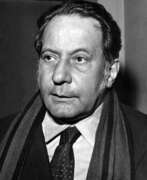



Pavel Efimovich Anosov (Russian: Павел Ефимович Аносов) was a remarkable artist and painter, renowned for his evocative depictions of the Zabaykalsky landscapes. Despite lacking formal artistic education, his passion for painting was ignited while working as a draftsman and later as an artist in a club. Following his demobilization in 1946, he joined the Chita Artistic Production Workshops of the Art Fund and attended the studio associated with the Fund. His artistic journey commenced, and by 1949, he was actively exhibiting his works.
Anosov's artistic focus predominantly revolved around the Zabaykalsky landscapes, capturing their essence with mesmerizing skill. In addition to landscapes, he ventured into still life paintings and thematic works. However, in the late 1970s, he left Chita, seeking new horizons. Today, his masterpieces are preserved in the archives of the Zabaykalsky Regional Museum, a testament to the enduring legacy of Pavel Anosov's artistic brilliance.


Louis Anquetin, a French painter, was a distinctive figure in the Post-Impressionist movement, known for his development of the Cloisonnism style alongside Émile Bernard. This style is characterized by bold outlines and flat areas of color, significantly influencing the aesthetic directions of their contemporaries. Anquetin’s career began in Paris, where he immersed himself in the avant-garde art scene, mingling with notable artists like Henri de Toulouse-Lautrec and Vincent van Gogh.
Louis Anquetin's works, such as "The Avenue de Clichy at Five o'clock" and "Woman at the Champs-Élysées by Night," reflect his fascination with Parisian street scenes and the vibrant nightlife of the city. These works are celebrated for their dynamic use of color and form, capturing the essence of urban life with a dramatic flair.
In the later part of his career, Anquetin shifted his focus towards studying the techniques of the Old Masters, particularly Pieter Paul Rubens, and even authored a book on Rubens in 1924. This marked a significant transition from his earlier avant-garde styles to a more traditional approach in his later works.
Louis Anquetin’s contributions to both the Post-Impressionist movement and his later academic studies remain influential. His works can be found in various prestigious collections, including the Musée d'Orsay and the Tate, highlighting his lasting impact on the art world.
For those interested in exploring more about Louis Anquetin's works or collecting his art, staying informed about exhibitions and sales is crucial. You can sign up for updates related to Anquetin's artwork and auction events, ensuring you never miss an opportunity to view or acquire his influential pieces.
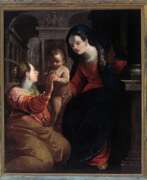

Giovanni Andrea Ansaldo was an Italian painter active mainly in Genoa. He trained under Orazio Cambiasi and possibly collaborated with Bernardo Strozzi. Ansaldo's works are typical of the Genoese eclecticism of the early 17th century, influenced by Flemish artists. Ansaldo was responsible for the fresco decoration of the cupola of the Basilica della Santissima Annunziata del Vastato of Genova. His Annunciation fresco is considered the first true Baroque painting in the city.
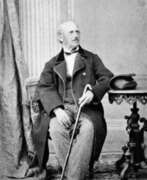

Hermann Anschütz was a German painter of the 19th century. He is known as a painter and teacher who belonged to the Düsseldorf School of painting. He was a professor at the Munich Academy of Fine Arts.
Anschütz painted mythological and historical subjects, as well as landscapes and portraits. A number of his canvases were devoted to oriental themes. In 1860 he was one of the founders of the Munich Christian Art Association.
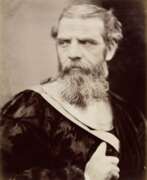

Richard Ansdell was a British painter of animals and genre scenes.
Ansdell's subject matter was compared to that of Edwin Landseer, though critical opinion was that, though popular, his works lacked the latter's emotional impact. His reputation was as a hardworking but occasionally over-proud artist; for instance, he received no royal commissions after refusing to paint Queen Victoria's dogs unless they were brought to his studio.


Adam Antes was a German painter, sculptor and graphic artist. He worked mainly as a sought-after portrait painter and also designed a single-wing aircraft.
Adam Antes was inspired by the styles of Auguste Rodin, Bernhard Hoetger and Wilhelm Lehmbruck. From time to time he turned to graphics. His work was part of the sculpture in the art competition at the 1932 Summer Olympics.
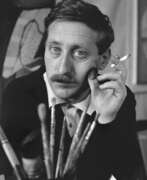

Horst Antes was a German painter, graphic artist and sculptor, a pioneer of the new figurative painting in Germany.
After studying at the Karlsruhe Academy of Fine Arts from 1957 to 1959, Antes taught there himself and later became a professor there.
Antes became known for the Kopffüßler (head-foot) image, which has been a recurring theme in his paintings, sculptures and graphic works since the early 1960s. Antes' work is represented in several major collections in Berlin, Hamburg, Cologne and elsewhere in Germany.
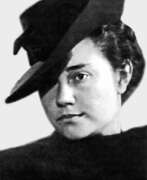

Evgenia Petrovna Antipova (Russian: Евгения Петровна Антипова) was a notable Russian painter, graphic artist, and art teacher. She stood out for her genre compositions, portraits, landscapes, and still lifes, primarily utilizing oils and watercolors. Evgenia Antipova's works often depicted apple orchards and Crimean landscapes, showcasing her profound connection to nature and her ability to capture its essence.
Evgenia Antipova's education at the prestigious Repin Institute of Arts shaped her artistic journey, leading to a career enriched with personal exhibitions and a significant presence in the art community. Not only did her artworks gain recognition in Russia, but they also found their way into international collections and exhibitions, notably in France, Germany, the United States, and the United Kingdom.
Throughout her career,Evgenia Antipova was an active participant in various significant exhibitions, displaying her works alongside other renowned artists. Her contributions to the art world were recognized with personal exhibitions in Saint Petersburg and inclusion in art auctions and exhibitions abroad.
Evgenia Antipova's paintings are part of prestigious collections, including the State Russian Museum, and continue to be celebrated in art museums and private collections globally. Her legacy as a prominent figure in the Leningrad School of painting endures, captivating art enthusiasts and collectors with her vivid and emotionally resonant works.
For those interested in Russian art, particularly the Leningrad School of painting, Evgenia Petrovna Antipova's oeuvre offers a rich exploration of genre compositions and landscapes, reflecting the artistic vibrancy of her era. Collectors and art experts are encouraged to delve into her works and consider signing up for updates on exhibitions and sales featuring her paintings.
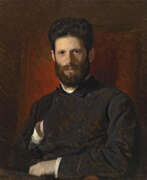

Mark Matveyevich Antokolsky (Russian: Марк Матве́евич Антоко́льский) was a 19th century Russian sculptor and writer. He is known as a representative of the realistic style and as the first sculptor of Jewish origin to gain international fame.
Mark Antokolsky devoted most of his career to the depiction in marble, plaster and bronze of the real characters of Russian history and achieved wide recognition already at a young age. His works were highly appreciated not only in Russia but also abroad and the artist was elected a member of many European academies of arts.
Mark Antokolsky was also a very successful writer. He often wrote publicistic articles on the development of the visual arts, and shortly before his death he published a novel describing real-life events in the life of the Jews in the Russian Empire.
Although from the early 1870s Mark Antokolsky spent most of his time living in France, he never lost touch with Russia - he constantly carried out orders for the royal family and the Russian Academy of Arts, wrote articles for Russian magazines, and regularly held solo exhibitions of his works in St. Petersburg.
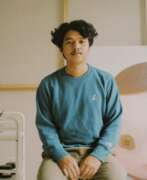

Roby Dwi Antono is a visual artist mainly creating surrealistic paintings as well as sculptures and prints. His work opens a portal to another universe where spaceships, aliens, dinosaurs and creatures with humanly features come together. These surrealistic creations that once lived only in Dwi Antono’s imagination come to life in a new realm on his canvas. Inspired by his childhood memories and love for Fiction movies, his paintings are left for the viewer to interpret.
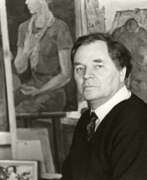

Fyodor Vasilievich Antonov (Russian: Фёдор Васильевич Антонов) was a Soviet and Russian artist of the twentieth century. He is known as a painter, graphic artist, textile artist, teacher, and professor.
Fyodor Antonov created landscapes, portraits and thematic compositions. In his genre works he immortalized the life and life of Soviet youth, as well as the formation of industry in the USSR. During the Great Patriotic War, the artist created portraits of heroes, as well as posters with a simple and direct pictorial form. Antonov's works are in various museum collections, including the Tretyakov Gallery, the Russian Museum and many private collections.
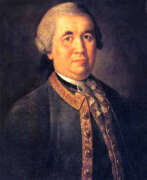

Alexei Petrovich Antropov (Russian: Алексей Петрович Антропов), a prominent Russian painter of the Baroque period, is celebrated for his significant contributions to art, particularly in portrait painting and church frescoing. Born into a family connected to the governmental sphere, Antropov's early exposure to the arts came through his work in the Chancellory of Buildings, where he began his career under the guidance of various Russian and foreign artists, including Andrey Matveyev and Ivan Vishnyakov.
Antropov's work is distinguished by his mastery in oil painting, miniatures, and icons, with a career that saw him active mainly in St. Petersburg, Moscow, and Kiev. His artistic journey was notably influenced by his studies with the French court painter Louis Caravaque and later with the Italian painter Pietro Rotari, which helped him refine his portrait artistry. The 1760s emerged as his most productive period, where he crafted numerous notable portraits, including those of Elizabeth Petrovna and Peter III of Russia, showcasing his preference for traditional icon and parsuna portrait styles characterized by sharp contrasts and dark backgrounds.
Antropov's legacy extends beyond his artworks; his dedication to art education and the community is evident in his decision to transfer his only house to the Department of Education for the establishment of a Free School. He passed away in 1795, leaving behind a rich collection of works that continue to be celebrated in museums such as the Tretyakov Gallery in Moscow and the Russian Museum in St. Petersburg.
Collectors and art experts value Antropov for his unique contributions to Russian art, his role in the transition of portrait styles, and his influence on future generations of artists, including his apprentice Dmitry Levitzky. His works, including the portraits of Catherine II and Archbishop Gavriil Petrov, are pivotal in understanding the artistic and cultural shifts of 18th-century Russia.
For those interested in exploring the depths of Russian Baroque art and the significant figures who shaped its contours, Alexei Petrovich Antropov's oeuvre offers a fascinating journey. Collectors and aficionados are encouraged to sign up for updates on new product sales and auction events related to Antropov's works, ensuring they remain informed about opportunities to own a piece of this illustrious artist's legacy. This subscription is a gateway to the vibrant world of art collection, where the beauty of the past is preserved for the future.


Pyotr Yakovlevich Anurin (Russian: Петр Яковлевич Анурин) was a Soviet and Russian artist of the second half of the twentieth century. He is known as a painter, author of lyrical landscapes, often depicting the architecture of ancient Russian cities.
Pyotr Anurin was nicknamed "spring artist" by his contemporaries for his subject matter, style and technique of painting. Spring was a special time for the master, during this period he created many canvases, such as "Spring", "The Last Snow" and others. The main theme of his works in the last years of his life was the Central Russian landscape.
The artist's works are in various art galleries and private collections in many countries, including Russia, England, Germany, France, Israel and China.
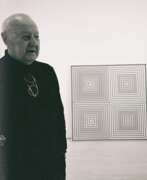

Richard Joseph Anuszkiewicz was a prominent American artist celebrated for his foundational contributions to the Op Art movement. Born in Erie, Pennsylvania, to Polish immigrant parents, Anuszkiewicz's early talent in art earned him scholarships, leading to his studies at the Cleveland Institute of Art and later, the Yale University School of Art and Architecture under Josef Albers. Albers, a pivotal figure in his career, inspired Anuszkiewicz to explore the intricacies of color and geometric forms, steering him away from realism towards a more abstract and mathematical approach to art.
Anuszkiewicz gained prominence in the 1960s, notably through his participation in the landmark exhibition "The Responsive Eye" at MoMA, which played a crucial role in propelling Op Art into mainstream recognition. His works, characterized by vibrant colors and geometric patterns, create illusions of depth and movement, challenging viewers' perceptions and offering a mesmerizing visual experience. His technique was not just about the visual impact; it was a meticulous, mathematical exploration of color and form, aiming to achieve a 'very, very mechanistic geometry' that was nonetheless romantic in its precision and purity.
Throughout his career, Anuszkiewicz's art evolved, yet he remained faithful to his intellectual and analytical approach, focusing on the optical effects of color and shape. His contributions extended beyond painting to include printmaking and sculpture, showcasing his versatility as an artist. Notably, his works are housed in prestigious collections around the world, including the Metropolitan Museum of Art, Museum of Modern Art, and the Whitney Museum of American Art, among others.
For collectors and experts in art and antiques, Anuszkiewicz's work embodies the confluence of scientific precision and artistic expression, offering insights into the profound impact of color and form on human perception. His legacy continues to inspire and challenge the boundaries of visual art.
If you're captivated by the transformative power of Op Art and the pioneering work of Richard Joseph Anuszkiewicz, sign up for updates. Stay informed about new product sales and auction events related to this remarkable artist's oeuvre, enriching your collection with pieces that resonate with history and innovation.
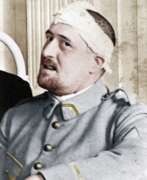

Guillaume Apollinaire, real name Wilhelm Albert Vladimir Apollinaris de Wąż-Kostrowicki, a French poet of Polish descent, was a towering figure in the early 20th century's literary and art scenes. Known for his experimental verse and support of avant-garde art movements like Cubism and Surrealism, Apollinaire's work pushed the boundaries of traditional aesthetics and inspired a generation of artists and writers.
Guillaume Apollinaire's literary contributions were vast and varied. He was an early advocate for Cubism, a relationship most prominently seen in his collaborations with artists like Pablo Picasso. He not only wrote about art but also collected it, surrounding himself with works by modernist masters such as Henri Rousseau and Georges Braque. His Paris apartment was a small museum of modern art, filled with pieces he often sold to support his literary endeavors. This vibrant artistic environment fueled his creativity, leading to major works such as Alcools and Calligrammes, which explored the possibilities of poetic form and typography to represent visual and verbal content in a unified way.
Despite his innovative work in poetry and art criticism, Guillaume Apollinaire's life was marked by personal challenges, including a grievous injury during World War I. Yet, even these difficulties did not hinder his prolific output. Among his notable works during this period was the play Les Mamelles de Tirésias, which was performed in 1917 and is considered a precursor to theatrical Surrealism.
Apollinaire's influence extended beyond his lifetime, particularly through his mentoring of future Surrealist leaders like André Breton. His forward-thinking approach to art and literature made him a central figure in the transition from traditional to modernist forms in both fields.
For collectors and experts in art and antiques, Guillaume Apollinaire's work represents a nexus of literary brilliance and pivotal artistic movements. His life and work provide fascinating insights into the dynamic and transformative world of early 20th-century art and literature.
Sign up for updates on auctions and sales events featuring items related to Guillaume Apollinaire. Stay informed about opportunities to acquire unique artifacts that celebrate his legacy in the realms of poetry and art.


Christiaan Karel Appel was a Dutch painter, sculptor, and poet. He started painting at the age of fourteen and studied at the Rijksakademie in Amsterdam in the 1940s. He was one of the founders of the avant-garde movement CoBrA in 1948. He was also an avid sculptor and has had works featured in MoMA and other museums worldwide.
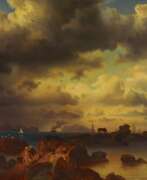

Emilia Appelgren was a Finnish artist, one of the first female landscape painters of 19th century Finland.
Emilia Appelgren was also a good copyist and illustrator. After the establishment of the Finnish Society of Artists in 1846, she studied at art schools at home and abroad.
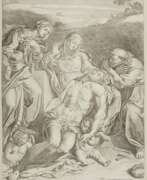

Pietro Aquila was an Italian painter and printmaker of the Baroque period. He was born in Palermo. He mentored his nephew, the printmaker Francesco Faraone Aquila. He trained at the school of Palermo painter and engraver Pietro del Po and worked, like a teacher, first at home, in Palermo, then in Naples and Rome, where he pursued the ecclesiastical career. For his paintings that he left in Palermo in the church of the Pietà (Parabola del Figlio Prodigo, Abraham and Melchizede) and in the cloister of S. Maria delle Vergini (S. Benedetto), as well as some frescoes in the Chapel of the Rosary in S. Cita, he gained the status of "respectable painter", loyal to the Raphaelesque tradition. But Aquila established himself first and foremost as a copper engraver, dedicating himself to the distribution and popularization of many of the most remarkable paintings with the help of which the sacred and profane buildings of Rome were adorned at that time. He made engravings after the works of different artists that were dear to him including: Raphael before any other, and then Annibale Carracci, Pietro da Cortona, Giovanni Lanfranco, Lazzaro Baldi, Ciro Ferri, Morandi, Franceschini, and finally Carlo Maratta, who was bound to him by a close friendship.


Francesco Faraone Aquila was an Italian engraver. In 1690 he moved to Rome where his brother Pietro had been an engraver for several decades in major workshops in the capital. Pope Clement XI gave him an order which has remained his main work - engraving the bas-reliefs of the Antoninus Pius column and its pedestal. Another important work by Francesco Aquila is the engraving of the frescoes of the dome of the Cathedral of Parma by Correggio and the painting of the Vatican chambers. Following the antique taste established in the 18th century, Aquila engraved various Roman classical works: statues, vases and triumphal arches, thus satisfying the demand of mainly foreign visitors, mainly German and English. His portraits of his contemporaries, both painters and clergymen, also enjoyed great popularity.
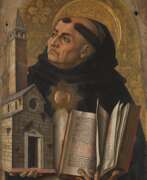

Thomas Aquinas (Italian: Tommaso d'Aquino, also called Aquinas, alias Doctor Angelicus) was an Italian poet and theologian, philosopher, and major medieval scholastic.
Thomas Aquinas is one of the most important theologians in the history of Western civilization, given the extent of his influence on the development of Roman Catholic theology since the fourteenth century. As a theologian, in his two masterpieces, Summa theologiae and Summa contra gentiles, he created the classical systematization of Latin theology, and as a poet, he wrote some of the most serious and beautiful Eucharistic hymns in the church liturgy. Thomas Aquinas is recognized by the Roman Catholic Church as the foremost Western philosopher and theologian and canonized as a saint.
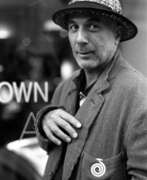

Ron Arad (Hebrew: רון ארד) is a contemporary Israeli-born artist, architect, and designer known for his innovative and boundary-pushing creations.
Throughout his career, Arad has explored various materials and techniques, embracing both handcrafted and technological processes. His designs often blur the boundaries between art and design, challenging conventional notions of form and function. Arad's furniture pieces are characterized by their sculptural qualities, organic shapes, and a sense of fluidity.
